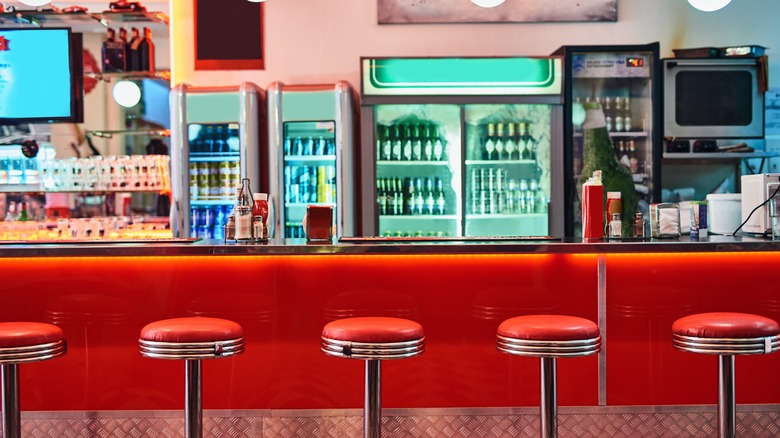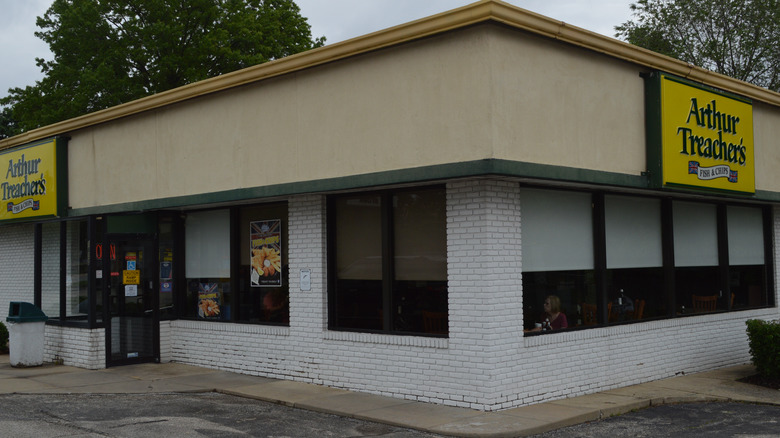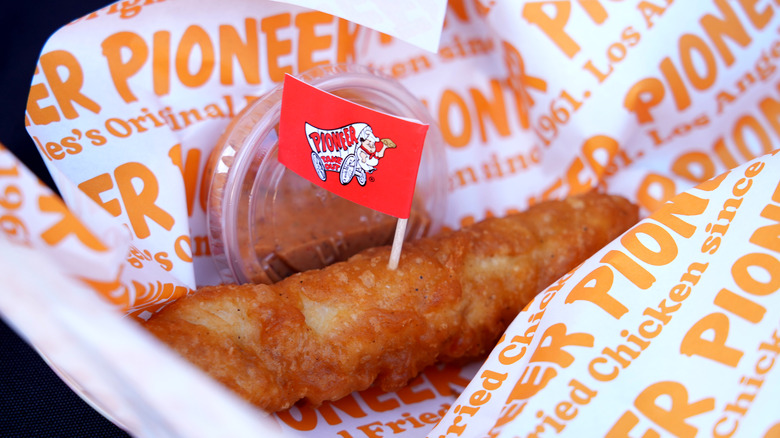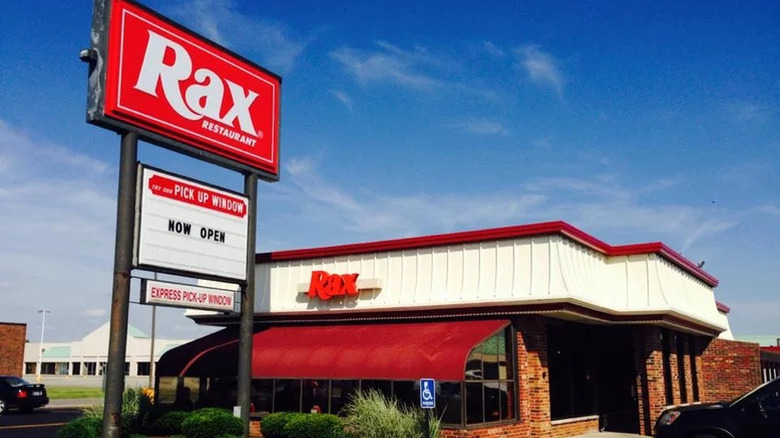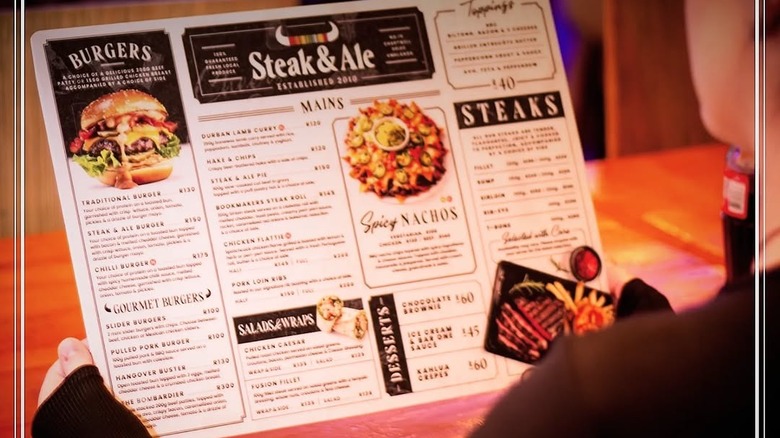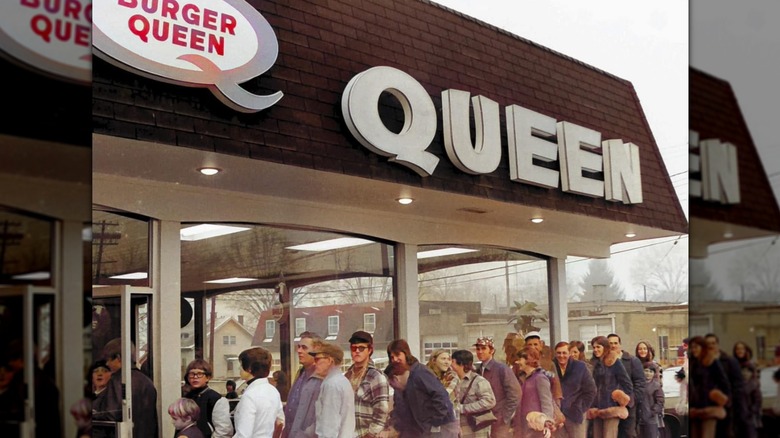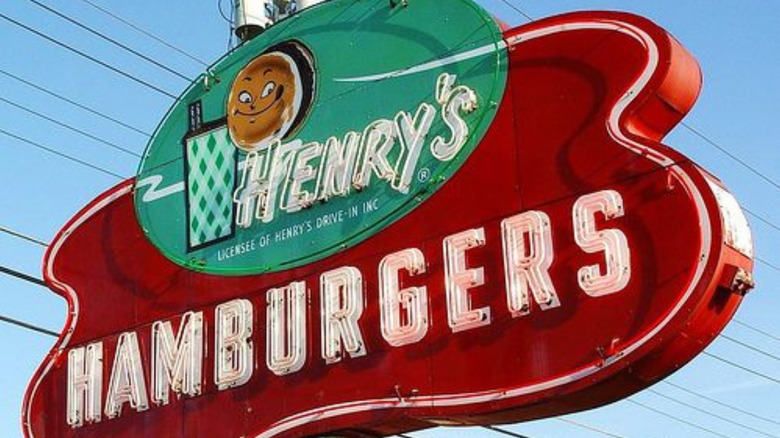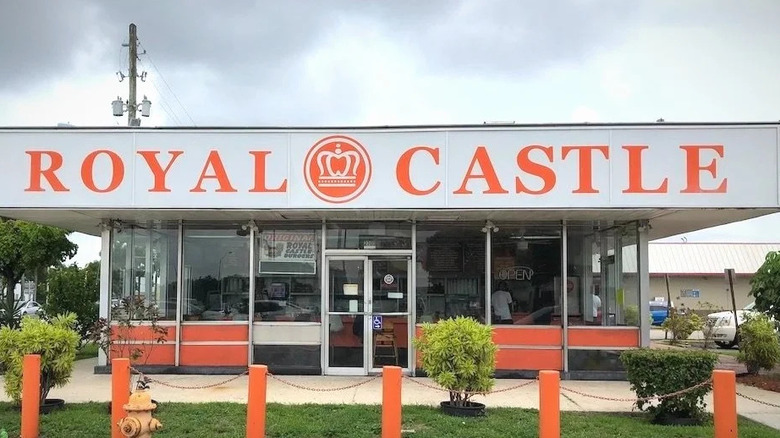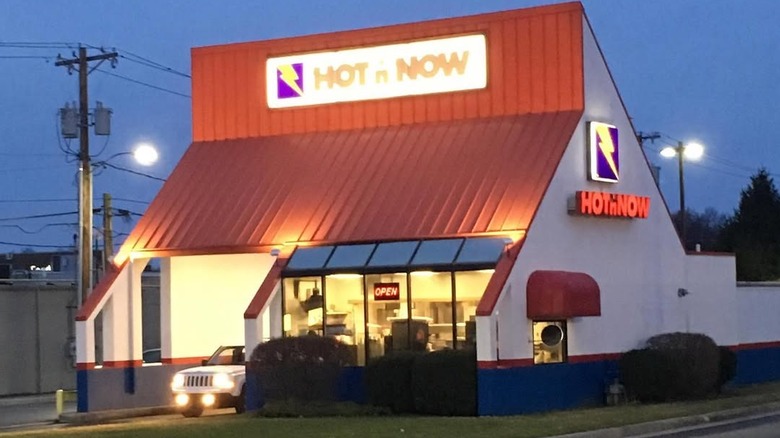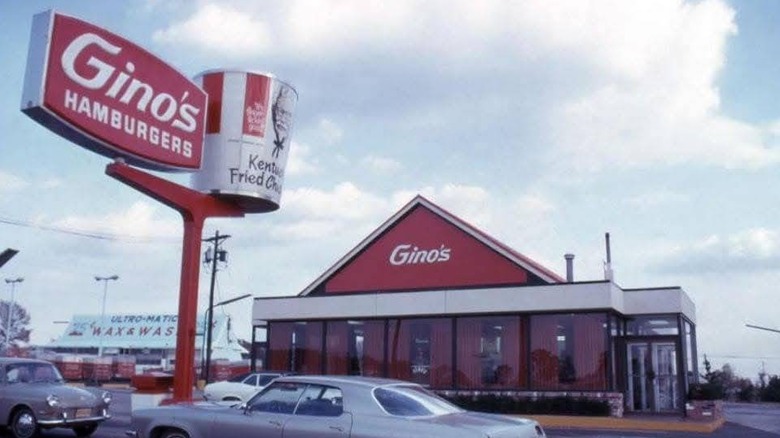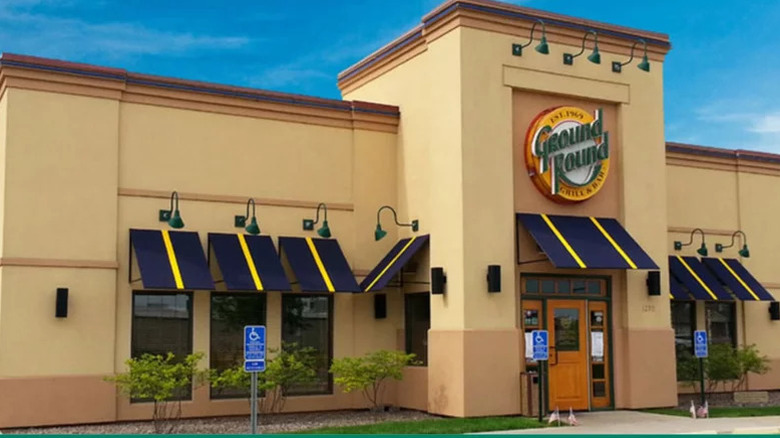10 Chain Restaurants You May Have Thought Were Totally Extinct
Chain restaurants have been pushing up against brutal headwinds for a while now. Rising labor and commodity costs, tariffs, and just general inflationary pressure have landed many in the industry — even giants like Red Lobster, TGI Fridays, and Hooters — in the throes of bankruptcy. But while alarming, this isn't exactly a new phenomenon. Chain restaurants have been biting the dust since the concept of chain restaurants took off. Some, like Burger Chef and Howard Johnson, completely vanished into obscurity despite boasting an almost ubiquitous nationwide presence at their peak.
But losing top-dog status doesn't necessarily spell the end for some chains; fate has its favorites, after all. Some, while no longer massive enough to stay top of mind, are still trucking along somewhere in the backroads of nostalgia. So, which lucky few have survived the death spiral? Here's a roundup of restaurant chains that, while massive in their heyday, have since fallen off to near-extinct status.
Arthur Treacher's Fish & Chips
Though the Brits might always dominate the fish n' chips game, plenty of American dives and chains can hold their own. Sadly, none of those is Arthur Treacher's Fish n' Chips; the Columbus, Ohio–based chain that ruled the fish n' chips scene in the '80s, when finding English-style fish n' chips served American-size was a rarity.
Everything came crashing down in the mid-'70s when the English and Irish cod wars sent the price of cod soaring, forcing the chain to switch to pollock. While fish n' chips is a pretty forgiving meal, nothing ruins it like using the wrong kind of fish for frying. Quality suffered, and with it, the chain's reputation. The crisis hit smack in the middle of expansions, which had been funded through sale-leaseback agreements. With rents piling up — to the tune of $61 million, per The Lakeland Ledger, and diner sentiment tanking, Arthur Treacher's began losing its footing in the seafood game.
Then came the rift with franchisees, who, faced with dwindling traffic, began absconding royalties, and filing lawsuits against parent company Orange Co. for forcing the pollock recipe on them. This kicked off a long, drawn-out legal battle that further strained the company's already-scarce resources. By the time Arthur Treacher's was handed off to Mrs. Paul's Seafood in 1979, it was already barreling toward collapse. Several ownership changes later, Arthur Treacher's had been involved in two bankruptcy filings, and its once 800+ unit portfolio had whittled down to scraps.
But while history would've already called time on most chains, Arthur Treacher's still lives on. Its Cuyahoga Falls and Garfield Heights, Ohio outposts managed to stay afloat amid the wreckage until 2021, when Garfield Heights shuttered; leaving Cuyahoga Falls as the last Arthur Treacher's standing in the country. That didn't last long, though. Just four years later, the brand pulled off an almost-miraculous revival, launching two new locations and bumping its total unit count up to three.
Pioneer Chicken
Though it's mostly been eclipsed by the likes of Popeyes, there was a time when Pioneer Chicken was among the most sought-after fried chicken chains in southern California. It had fried chicken served extra-crispy, extra-greasy, and extra-orange, a lovable mascot — think Mr. Monopoly, but in a 10-gallon hat and bolo tie — and a whopping 270-unit footprint.
Things started going south in the late 1980s when a combination of internal wrangles and crushing debt forced the chain into bankruptcy. About 10 of the 23 corporate-owned units were scrapped to pave the way for restructuring, which later crumbled owing in part to wrangles between the chain's management and disgruntled franchisees. By 1991, the chain's revenue had tanked by half, and its net worth was speedily approaching negative seven figures; all of which made a second bankruptcy filing imminent. Two years later, the chain was acquired by Popeyes' owner, AFC Enterprises, which converted most of the remaining units into Popeyes.
Though it's not quite as ubiquitous as it used to be, Pioneer Chicken has not left the fried chicken game; you can still score a bucket of those very orange birds. Of course, your chances are much higher in Indonesia, where, presumably spurred by nostalgia, three USC alumni founded California Fried Chicken — a spinoff of Pioneer Chicken — whose unit portfolio more or less dwarfs the original at over 200. You'll have a lot less luck stateside since southern California, once home to the iconic chain, only has two outposts left: one in Boyle Heights and the other in Bell Gardens.
Rax Roast Beef
If you're wondering whether a restaurant that specializes in roast beef sandwiches would do alright for itself, the answer is a resounding yes, and the proof is Rax Roast Beef. This Ohio–based fast-food chain rode the roast beef train so hard it grew to 500 stores across 38 states, at one point going neck and neck with Arby's. But although sticking to roast beef sandwiches was working out just fine for Rax, the chain inexplicably began a series of dramatic menu overhauls in the late '80s; adding salad bars, pasta bars, tacos, tortilla bowls, and even Chinese food.
Hot on the heels of those menu changes came architectural redesigns — cafeteria-style dining rooms, wood accents, sun-soaked solariums — all of which demanded heavy capital investment and, worse, alienated Rax's core customers. By the early '90s, profits were tanking fast, and perhaps in a desperate attempt to save face, Rax rolled out an ad campaign featuring Mr. Delicious; arguably the most embattled and depressed fast-food mascot to ever exist. Predictably, diners didn't respond well to Mr. Delicious' sad dad shtick. Three months after the campaign aired, Rax filed for bankruptcy.
The brand changed hands multiple times afterward, each new owner chipping away at its once-sprawling portfolio. Today, only a handful of Rax restaurants remain; all owned by Rich Donohue, a former Rax employee and longtime franchisee who bought the Rax trademark in 2007 with hopes of reviving the brand. Donohue even opened a new outpost in New Carlisle, Ohio in 2022, nudging the chain's unit count to six.
Steak & Ale
Though it may have fallen off in recent years, there was a time when casual dining ruled the industry. And no chain is more emblematic of the rise of casual dining than Steak & Ale. This chain basically wrote the script on casual dining, carving out a sweet spot between fine dining and making a quick stop at a drive-through after work. At Steak & Ale, value dining meant free drink refills, wine samples for a quarter, all-you-can-eat salad bars, decadent desserts thrown in just for showing up before six, and, of course, generous cuts of prime rib; in essence, getting stuffed and a little tipsy without torching your wallet.
Being among the first of its kind, Steak & Ale exploded in the '80s, at one point boasting a unit count of nearly 300. Things took a nosedive amid the 2008 recession, when, under strain from rising commodity and labor costs, parent company S&A Restaurant Group — also owner of Bennigan's — filed for Chapter 7. All existing Steak & Ale stores shuttered in the aftermath.
Years later, the brand was sold off to Legendary Restaurant Brands, which made multiple attempts to revive it over the course of a decade. Most attempts fizzled; until 2023, when the company struck a deal with Endeavor Properties to open 15 Steak & Ales in the United States. The first made its debut in Burnsville, Minnesota, in mid-2024. A second, planned for Grand Prairie, Texas, fell through, but even with one restaurant open, it's safe to say that Steak & Ale is no longer a relic.
Burger Queen
Before it entered its long-standing rivalry with McDonald's, Burger King's fiercest rival wasn't Wendy's or Jack in the Box; it was Burger Queen, a Kentucky-based chain that sprang up in the '60s and really hit its stride by the early '80s. At its peak, Burger Queen boasted nearly 200 locations, not just across the U.S., but as far afield as Taiwan, Canada, and the United Arab Emirates.
The rivalry cooled a tad when Burger Queen changed its name to Druther's, a cheeky play on its marketing slogan, "I'd Ruther Go to Druther's." Change isn't necessarily a bad thing. Plenty of chain restaurants look way different now than when they first started. Burger King, for instance, has gone through a series of evolutions in its half-century history, some of which have landed way off target. One thing it's never done, though, is detract from its core offering: burgers. That's exactly where Burger Queen went wrong when it became Druther's. To be fair, Druther's did have some pretty solid offerings beyond burgers. In fact, shifting focus might actually have been its best shot at survival. Burger King and McDonald's, with millions to burn on marketing and expansion, were fast edging out everyone else in the burger space. But no sooner had the new name sunk in than the company decided it "Druther" be something else entirely: a Dairy Queen.
Its parent company, Druther's International Inc., cut a deal to operate Dairy Queen territories, and roughly 117 Druther's locations — nearly the entire chain — were converted. Only one outpost, in Campbellsville, Kentucky, survived the rebrand, largely because there was already a Dairy Queen next door. Today, that single restaurant is the only reason Druther's — and by extension, Burger Queen — hasn't retreated to complete obscurity, though it's safe to say it'll never catch up to the King.
Henry's Hamburgers
Given how well burger heavyweights like McDonald's have been weathering inflation, you might think burgers have always — and will always — be America's go-to comfort food. But they haven't always been so top of mind. Fast food burgers didn't really start booming until the 1950s, when car culture took over and drive-ins allowed chains to sling patties at a scale no one had imagined before.
And it wasn't just a two-horse race between McDonald's and Burger King. Plenty of now-obscure fast food chains were duking it out for dominance; one of which was Henry's Hamburgers. For a time, it seemed like Henry's would make it out of the fray barely a scratch on it. For one, it was flipping burgers faster than anyone else; which you really have to when you're selling them 10 at a go for $1. And car culture wasn't going anywhere, what with the interstate highway system growing and people buying cars in droves.
All that was true. But what Henry's might've forgotten is that cars might stick around, people might still love burgers, but drive-ins were a passing fad. By the mid-1970s, diners were over the drive-in setup, and drive-throughs took over. Everyone in the industry rushed to adjust; everyone except Henry's. Under pressure from competition, franchises across the country began shuttering, slowly wiping out Henry's sprawling 200+ unit portfolio. Today, only one Henry's Hamburgers outpost remains; in Benton Harbor, Michigan. And, no, it's not still using a drive-in setup; it's since transitioned to drive-through. A little too late, it appears.
Royal Castle
Yet another burger chain that got its legs cut out from under it in the 1970s is Royal Castle. Inspired by the success of fast food pioneer White Castle, Royal Castle had nearly 200 locations in its heyday, spurred on by such attractions as $0.15 hamburgers, $0.05 birch beer (think root beer, but lighter, less sweet, and made from tree bark) served in frosted mugs, and that quintessential flat-top store design.
By the mid-1960s, Royal Castle had grown too big for the mom-and-pop ledger and made its debut on the trading floor. Just a few years later, it was sold to Tennessee-based Performance Systems. The ink on the deal had barely dried when Performance Systems reported losses of nearly $40 million and got tangled in a securities fraud scandal for fudging its financials and tampering with stock prices.
Still deep in the red, the company tried to claw its way back by franchising at a higher cost, to no avail. Then, in an attempt to gain ground against newer, but fast-growing entrants like McDonald's and Burger King, Royal Castle began making burgers ahead of time, which whittled down quality and hurt sales. By the mid-1970s, stockholders were ready to call it a day, selling off the company's assets at throwaway prices, mostly to employees. James Brimberry, then an employee, snagged himself seven stores from the wreck and held on for decades, slowly selling most of them off. Today, only one outpost remains in Miami, still standing, still serving, and still pouring that birch beer.
Hot 'n Now Hamburgers
Burgers might now be a baseline offering, but there was a time they were a pretty hot commodity in the fast-food world. Everyone was making them, and everyone wanted to be different. Then came Hot 'n Now Hamburgers. While everyone else was rushing to pad their models, Hot 'n Now kept operations simple; no playgrounds, wood-paneled interiors, or all-you-can-eat salad bars; just food served hot and, well, now.
With a model that lean, it's no wonder Hot 'n Now could sell a burger, fries, and soda combo for $0.39; a price point only comparable to what McDonald's charged when it first opened. Edging out the competition with pricing, Hot 'n Now grew rapidly in the '90s, opening more than 150 locations across more than a dozen states at its peak. Things started going south when the chain was scooped up by soda giant PepsiCo in 1991. Now under Taco Bell, the brand evolved so fast — and in so many convoluted directions — that it became clear executives were using it as a testing ground for new strategies. The identity crisis didn't go unnoticed by patrons; sales tanked and, with them, much of Hot 'n Now's portfolio.
By the 2010s, the brand had changed hands nearly a dozen times, been involved in a lawsuit, and lost all but two of its units; one in Sturgis and another in Bay City, Michigan. In 2016, a fire erupted at the Bay City location, leaving Sturgis as the last outpost. This lonely reign didn't last long, though. Just eight years later, the brand was snapped up by Michigan-based HNN Holdings, which has since added one more location in Wayland, Michigan, with plans for an additional spot in Alpena.
Gino's Hamburgers
There are plenty of reasons why hamburgers just taste better at restaurants. Sometimes, it's the secret ingredients — like, say, a splash of soda in the patty meat — that make the difference. But other times, it all comes down to layering, an art perfected by only a few burger joints, one of which was Gino's Hamburgers. Known for its philanthropic streak, Gino's exploded in the '70s, reaching a footprint of 450 locations, most of them clustered across the Northeast. Fast food was having a moment then, sure, but Gino's secret sauce wasn't just timing. It also had some pretty solid menu items, one of which was the Gino Giant, a burger stacked so high and so elegantly that its only real rivals were the Big Mac and the Whopper.
Things started going south in 1981, when the chain pulled the Gino Giant from its menu and replaced it with the underwhelming Gino Hero. The move was so poorly received that Gino's revenue tanked by $1.63 million that year. But the menu overhaul wasn't what ultimately wiped Gino's off the map. Just a year after the overhaul, the chain inked a $48.6 million acquisition deal with Marriott Corporation, owner of rival chain Roy Rogers. Marriott immediately converted almost all existing Gino's units to Roy Rogers, leaving just a few outposts, the last of which shuttered in 1986.
Gino's remained a nostalgic relic until 2010, when former COO Tom Romano, alongside founders Louis Fischer and Gino Marchetti, brought it back as Gino's Burgers and Chicken. For a while, Gino's seemed poised to make one of the most dramatic comebacks in fast food history. Locations popped up in King of Prussia, Bensalem, and later across Maryland, from Towson to Camden Yards. But by 2016, nearly all had shuttered again, leaving only Towson and Glen Burnie still standing.
Ground Round
Before its decades-long reign over the casual dining space lapsed, Howard Johnson's made multiple attempts to claw its way back to profitability; one of which was launching the casual dining concept, Ground Round. Designed to convert faltering Howard Johnson units, the chain took off in the mid-'70s and early '80s, hitting a nationwide footprint of over 200 locations at its peak. But by the late '80s, it too had hit hard times. A revolving door of owners, ballooning debt, and intensifying competition sent the brand into a slow, steady decline. The real death knell came in the early 2000s, when creditors Foothill Capital Management and Boston Ventures Management pulled the plug on the chain's credit line after years of defaulted payments. In dire straits, Ground Round filed for bankruptcy, shuttered all corporate stores, and laid off much of its workforce in one fell swoop.
The chain was subsequently acquired by Ground Round Independent Owners Cooperative LLC, a consortium of franchisees, which, despite making a solid attempt to pay off outstanding debts, couldn't steer the chain toward a resurgence. Ground Round's portfolio gradually thinned over the coming decades, leaving only four locations — one in Ohio and three in North Dakota — still standing. But with Massachusetts couple Joseph and Nachi Shea, who acquired the rights to the brand in 2024, now at the helm, the chain might just get a new lease on life. The two have since added one more location — in Shrewsbury, Massachusetts — to the chain's portfolio, bringing it five further from extinction.
Static Media owns and operates Food Republic and Money Digest.

